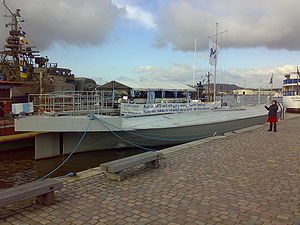HSwMS Sölve

HSwMS Sölve monitor
|
|
| History | |
|---|---|
|
|
|
| Name: | HSwMS Sölve |
| Namesake: | Sölve |
| Builder: | Ericsson-D'Ailly |
| Launched: | 1875 |
| Out of service: | 1919 |
| Reclassified: | Converted into an oil barge, 1919? |
| Fate: |
|
| General characteristics | |
| Type: | Hildur-class monitor |
| Displacement: | 460 metric tons (450 long tons) (deep load) |
| Length: | 39.78 m (130 ft 6 in) |
| Beam: | 8.72 m (28 ft 7 in) |
| Draft: | 2.7 m (8 ft 10 in) |
| Installed power: | |
| Propulsion: | 2 shafts, 2 steam engines |
| Speed: | 8 knots (15 km/h; 9.2 mph) |
| Complement: | 48 |
| Armament: |
|
| Armor: |
|
HSwMS Sölve is one of the seven Hildur-class monitors built for the Swedish Navy in the mid-1870s. It had an uneventful career and was sold in 1919 for conversion into a barge. She became a museum ship in Gothenburg, Sweden, in 1992.
The Hildur-class monitors were designed by Lieutenant John Christian d'Ailly, from a proposal by John Ericsson, for the defense of Lake Mälaren and the . Sölve was 39.78 meters (130 ft 6 in) long overall and had a beam of 8.72 meters (28 ft 7 in). She had a draft of 2.7 meters (8 ft 10 in) and displaced 460 metric tons (450 long tons). Her crew numbered 48 officers and men. The ship had rudders at bow and stern.
The Hildur-class ships had two horizontal, twin-cylinder steam engines, each driving a single propeller using steam from two cylindrical boilers. The engines produced a total of 155 indicated horsepower (116 kW) which gave the monitors a maximum speed of 8 knots (15 km/h; 9.2 mph). The ships carried 23–25 metric tons (23–25 long tons) of coal.
Sölve was equipped with one 240-millimeter (9.4 in) M/69 rifled breech loader, mounted in a long, fixed, oval-shaped gun turret. The gun weighed 14,670 kilograms (32,340 lb) and fired projectiles at a muzzle velocity of 397 m/s (1,300 ft/s). At its maximum elevation of 7.5° it had a range of 3,500 meters (3,800 yd). The ship also mounted two 75-millimeter (3.0 in) guns. She was rearmed with a 120-millimeter (4.7 in) quick-firing gun as well as three 57-millimeter (2.2 in) quick-firing guns sometime in the 1890s or the early 1900s.
...
Wikipedia
